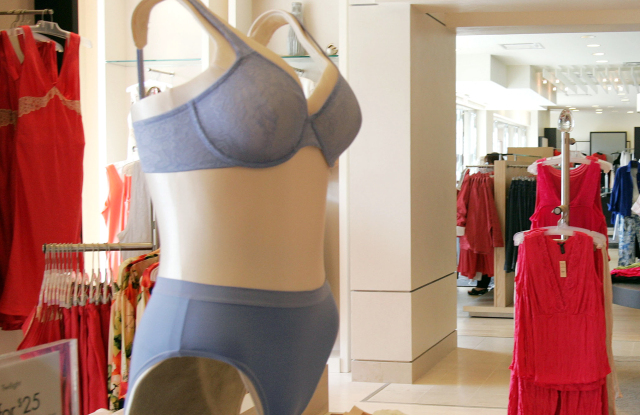HanesBrands Beats Quarterly Expectations Thanks to PPE Production – WWD
HanesBrands is making a comeback thanks to an early shift to personal protective gear and a rise in comfortable attire during the pandemic.
The Winston-Salem, N.C.-based innerwear and activewear company — parent to brands such as Hanes, Bali, Playtex, Maidenform, L’eggs and Wonderbra, among others — reported quarterly earnings Thursday before the bell, falling short on top-line revenues (but still beating expectations), while growing bottom-line profits.
For the three-month period ending June 27, total company revenues were $1.73 billion, down from $1.76 billion a year earlier, while profits were $161 million, up from $149 million the same time last year. Shares of HanesBrands shot up more than 10 percent during premarket hours as a result, only to close down 2.60 percent to $14.26 a piece Thursday.
“The HanesBrands organization did a phenomenal job overcoming significant challenges in order to mitigate the effects of the global pandemic,” Gerald W. Evans Jr., HanesBrands chief executive officer, said in a statement. “Despite the effects of pandemic-caused disruptions to global economies, our business is in great shape. We performed significantly better than our base-case scenario in both our apparel business and our new protective garment business. Point-of-sale trends are improving for apparel and in the case of [the] U.S. innerwear basics and U.S. Champion [business], point-of-sale trends in May and June were higher than pre-COVID-19 levels.
“Our brands are strong and we are gaining market share and building momentum,” Evans continued. “While there is still near-term uncertainty concerning the ongoing economic impact of the COVID-19 pandemic, we believe we are positioned to drive growth and seize opportunities over the next several years.”
He added that the company ended the quarter in a strong liquidity position of about $1.8 billion on the balance sheet.
Like so many retailers, the company had to temporarily close 1,200 brand stores in the U.S., Europe and Australia in March to prevent the spread of COVID-19. But that same month, HanesBrands was one of the first retailers to shift to mass producing cotton face masks.
The early efforts paid off. HanesBrands sold $752 million in personal protective garments to governments, large organizations, other businesses and consumers around the world during the quarter. (That includes more than 450 million face coverings and more than 20 million medical gowns to the U.S. government.)
HanesBrands now expects to sell more than $150 million worth of protective gear in the second half, excluding the potential for additional government contracts.
Evans said on Thursday morning’s conference call with analysts that the consumer face mask business alone could grow to $200 million to $300 million on an annualized basis.
“Relative to future government business, there certainly could be additional opportunities out there and we’ll certainly seek those as the opportunity emerges,” Evans said on the call. “We believe that there’s a permanent consumer behavior change that’s going to last for some time. Our research tells us the consumer is really looking for a trusted brand and innovation and it’s right up our alley and we’re having a good response.”
And while apparel and activewear sales were down for the quarter, 29 percent and 62 percent, respectively, the figures were partially offset by gains in online sales, from the company’s e-commerce businesses and wholesale web sites. Total global online sales rose 70 percent during the quarter. Champion’s e-commerce business surged 200 percent during the quarter.
“We clearly see that the consumer is pursuing the brand, even when channels are closed,” Evans said. “They’re pursuing it online. In China, we’ve seen very nice growth there online as well. So, there’s just a lot of energy in Champion. We remain very bullish on our ability to reach our $3 billion goal over time.”
In addition, HanesBrands was able to leverage channels that stayed open during the pandemic, such as mass retail, food and drug stores and Dollar General Stores, which sell Hanes socks and hosiery.
“Over the last 15 years, [HanesBrands] have been focused on supply chain optimization, geographic and channel diversification and [free cash flow] generation,” Jay Sole, an analyst at UBS, wrote in a note. “[Management] has achieved its goals in these areas. Now, investors see [HanesBrands] handing the baton to someone who may prioritize organic growth. If these reasons play out, the narrative could become [HanesBrands] owns a portfolio of strong brands leveraged to fast growing channels (e.g. Walmart, Amazon) and categories (athleticwear).”
The company incurred about $63 million in both planned restructuring costs and additional COVID-19-related expenses during the quarter.
HanesBrands is not providing forward-looking guidance, but Evans remains optimistic on the company’s future thanks to the upcoming back-to-school season and HanesBrands strength in basics.
“It’s certainly a replenishment item,” he said. “In the event, in the unexpected event that there could be [another] lockdown of certain channels, we think we’re well-positioned to pick that up online. So we expect it to be a good back-to-school [season] from the standpoint of performance relative to the market we’re operating in.”
On Aug. 3, Stephen B. Bratspies will take over as ceo and board member of HanesBrands, succeeding Evans, who is retiring after 37 years at the company.




:quality(85):upscale()/2023/09/25/997/n/1922564/9d9b4e966512101ef18661.70108950_.png)
